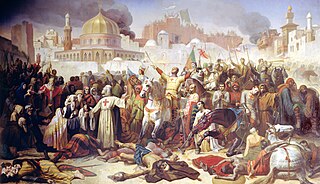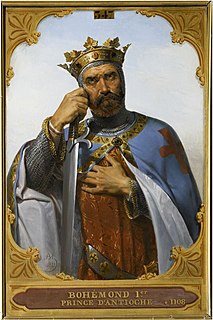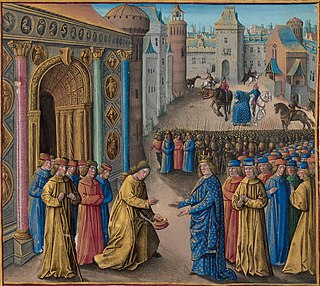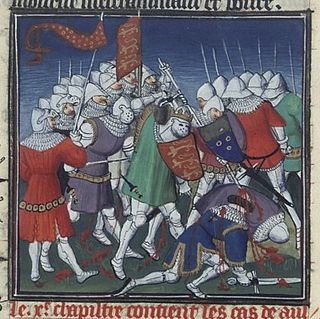Related Research Articles

Year 1099 (MXCIX) was a common year starting on Saturday of the Julian calendar.

Year 1098 (MXCVIII) was a common year starting on Friday of the Julian calendar.
The 1100s was a decade of the Julian Calendar which began on January 1, 1100, and ended on December 31, 1109.
The 1140s was a decade of the Julian Calendar which began on January 1, 1140, and ended on December 31, 1149.
The 1110s was a decade of the Julian Calendar which began on January 1, 1110, and ended on December 31, 1119.

Year 1101 (MCI) was a common year starting on Tuesday of the Julian calendar. It was the 2nd year of the 1100s decade, and the 1st year of the 12th century.

Year 1097 (MXCVII) was a common year starting on Thursday of the Julian calendar.

Year 1107 (MCVII) was a common year starting on Tuesday of the Julian calendar.

Year 1103 (MCIII) was a common year starting on Thursday of the Julian calendar.

Year 1148 (MCXLVIII) was a leap year starting on Thursday of the Julian calendar.

Year 1096 (MXCVI) was a leap year starting on Tuesday of the Julian calendar.

Year 1102 (MCII) was a common year starting on Wednesday of the Julian calendar.

Year 1104 (MCIV) was a leap year starting on Friday of the Julian calendar.

Year 1105 (MCV) was a common year starting on Sunday of the Julian calendar.

Year 1106 (MCVI) was a common year starting on Monday of the Julian calendar.
Year 1108 (MCVIII) was a leap year starting on Wednesday of the Julian calendar.

Baldwin I, also known as Baldwin of Boulogne, was the first count of Edessa from 1098 to 1100, and king of Jerusalem from 1100 to his death. He was the youngest son of Eustace II, Count of Boulogne, and Ida of Lorraine and married a Norman noblewoman, Godehilde of Tosny. He received the County of Verdun in 1096, but he soon joined the crusader army of his brother Godfrey of Bouillon and became one of the most successful commanders of the First Crusade.
Bohemond I of Antioch, also known as Bohemond of Taranto, was the prince of Taranto from 1089 to 1111 and the prince of Antioch from 1098 to 1111. He was a leader of the First Crusade, leading a contingent of Normans on the quest eastward. Knowledgable about the Byzantine Empire through earlier campaigns with his father, he was the most experienced military leader of the crusade.

Pons was count of Tripoli from 1112 to 1137. He was a minor when his father, Bertrand, died in 1112. He swore fealty to the Byzantine Emperor Alexios I Komnenos in the presence of a Byzantine embassy. His advisors sent him to Antioch to be educated in the court of Tancred of Antioch, ending the hostilities between the two crusader states. Tancred granted four important fortresses to Pons in the Principality of Antioch. Since Pons held his inherited lands in fief of the kings of Jerusalem, Tancred's grant strengthened the autonomy of the County of Tripoli. On his deathbed, Tancred also arranged the marriage of his wife, Cecile of France, to Pons.
The Treaty of Devol was an agreement made in 1108 between Bohemond I of Antioch and Byzantine Emperor Alexios I Komnenos, in the wake of the First Crusade. It is named after the Byzantine fortress of Devol. Although the treaty was not immediately enforced, it was intended to make the Principality of Antioch a vassal state of the Byzantine Empire.
References
- ↑ Gilbert Meynier (2010). L'Algérie cœur du Maghreb classique. De l'ouverture islamo-arabe au repli (658-1518). Paris: La Découverte; p. 83.
- ↑ Steven Runciman (1952). A History of the Crusades. Vol II: The Kingdom of Jerusalem, pp. 96–97. ISBN 978-0-241-29876-3.
- ↑ Brian Todd Carey (2012). Road to Manzikert: Byzantine and Islamic Warfare (527–1071), p. 160. ISBN 978-1-84884-215-1.
- 1 2 Picard, Christophe (2000). Le Portugal musulman (VIIIe-XIIIe siècle. L'Occident d'al-Andalus sous domination islamique. Paris: Maisonneuve & Larose. p. 109. ISBN 2-7068-1398-9.
- ↑ Brian Todd Carey (2012). Road to Manzikert: Byzantine and Islamic Warfare (527–1071), p. 160. ISBN 978-1-84884-215-1.
- ↑ "Carlisle Castle". English Heritage. Archived from the original on 2008-01-10. Retrieved 2007-12-21.
- ↑ "Lincoln Cathedral website". Archived from the original on January 10, 2008. Retrieved 2007-12-21.
- ↑ Stratton, J. M. (1969). Agricultural Records. London: John Baker. ISBN 0-212-97022-4.
- ↑ Basil Dmytryshyn (2000). Medieval Russia: A sourcebook 850–1700, p. 60. Academic International Press.
- ↑ "Norman Britain". British History Timeline. BBC . Retrieved 2007-12-21.
- 1 2 Palmer, Alan; Veronica (1992). The Chronology of British History. London: Century Ltd. pp. 56–58. ISBN 0-7126-5616-2.
- ↑ Timothy Venning (2015). A Chronology of the Crusades, p. 24. ISBN 978-1-138-80269-8.
- ↑ Picard C. (1997). La mer et les musulmans d'Occident au Moyen Age. Paris: Presses Universitaires de France.
- ↑ Potter, Philip J. (2009). Gothic Kings of Britain: The Lives of 31 Medieval Rulers (1016–1399), pp. 127–128. Jefferson, North Carolina: McFarland. ISBN 978-0-7864-4038-2.
- ↑ Steven Runciman (1951). A History of the Crusades. Volume I: The First Crusade and the Foundation of the Kingdom of Jerusalem, p. 101. ISBN 978-0-141-98550-3.
- ↑ Gerd Mentgen. Crusades in Antisemitism: A Historical Encyclopedia of Prejudice and Persecution (Vol 1), ed. Richard S. Levy, pp. 151–53.
- ↑ Steven Runciman (1951). A History of the Crusades. Volume I: The First Crusade and the Foundation of the Kingdom of Jerusalem, p. 102. ISBN 978-0-141-98550-3.
- ↑ Chazan, R. (1996). European Jwery and the First Crusade, p. 122. University of California Press. ISBN 978-0-520-20506-2.
- ↑ Steven Runciman (1951). A History of the Crusades. Volume I: The First Crusade and the Foundation of the Kingdom of Jerusalem, p. 115. ISBN 978-0-141-98550-3.
- ↑ Steven Runciman (1951). A History of the Crusades. Volume I: The First Crusade and the Foundation of the Kingdom of Jerusalem, pp. 116–117. ISBN 978-0-141-98550-3.
- ↑ Steven Runciman (1951). A History of the Crusades. Volume I: The First Crusade and the Foundation of the Kingdom of Jerusalem, p. 104. ISBN 978-0-141-98550-3.
- ↑ Steven Runciman (1951). A History of the Crusades. Volume I: The First Crusade and the Foundation of the Kingdom of Jerusalem, p. 105. ISBN 978-0-141-98550-3.
- ↑ Steven Runciman (1951). A History of the Crusades. Volume I: The First Crusade and the Foundation of the Kingdom of Jerusalem, pp. 107–108. ISBN 978-0-141-98550-3.
- ↑ Steven Runciman (1951). A History of the Crusades. Volume I: The First Crusade and the Foundation of the Kingdom of Jerusalem, p. 109. ISBN 978-0-141-98550-3.
- ↑ Catlos, Brian A. (2004). The victors and the vanquished: Christians and Muslims of Catalonia and Aragon, 1050-1300. Cambridge University Press. p. 13. ISBN 0-521-82234-3.
- ↑ Abels, Richard Philip; Bernard S. Bachrach (2001). The Normans and their adversaries at war. Woodbridge: Boydell & Brewer. p. 92. ISBN 0-85115-847-1.
- 1 2 Rickard, J. "Antioch, crusader siege of, 21 October 1097-3 June 1098" . Retrieved 4 January 2012.
- ↑ Rickard, J. "Battle of Harenc, 9 February 1098" . Retrieved 4 January 2012.
- ↑ Picard C. (1997). La mer et les musulmans d'Occident au Moyen Age. Paris: Presses Universitaires de France.
- ↑ Abels, Richard Philip; Bernard S. Bachrach (2001). The Normans and their adversaries at war. Woodbridge: Boydell & Brewer. p. 92. ISBN 0-85115-847-1.
- ↑ Tyerman, Christopher (2006). God's War: A New History of the Crusades, p. 134. The Belknap Press of Harvard University Press. ISBN 978-0-674-02387-1.
- ↑ Andrew Roberts (2011). Great Commanders of the Medieval World (454–1582), p. 121. ISBN 978-0-85738-589-5.
- ↑ Rickard, J. "Battle of the Orontes, 28 June 1098 (First Crusade)" . Retrieved 4 January 2012.
- ↑ Benvenuti, Gino (1985). Le Repubbliche Marinare. Amalfi, Pisa, Genova e Venezia. Rome: Newton & Compton Editori. p. 34. ISBN 88-8289-529-7.
- ↑ Siecienski, Anthony Edward (2010). The Filioque: History of a Doctrinal Controversy. Oxford University Press. pp. 117–118. ISBN 9780195372045.
- ↑ Steven Runciman (1951). A History of the Crusades. Volume I: The First Crusade and the Foundation of the Kingdom of Jerusalem, p. 221. ISBN 978-0-141-98550-3.
- ↑ Steven Runciman (1951). A History of the Crusades. Volume I: The First Crusade and the Foundation of the Kingdom of Jerusalem, p. 222. ISBN 978-0-141-98550-3.
- ↑ Steven Runciman (1951). A History of the Crusades. Volume I: The First Crusade and the Foundation of the Kingdom of Jerusalem, p. 224. ISBN 978-0-141-98550-3.
- ↑ David Nicolle (2003). The First Crusade 1096–99 - Conquest of the Holy Land, pp. 69–70. Osprey Publishing: Campaign 132. ISBN 978-1-84176-515-0.
- ↑ Steven Runciman (1951). A History of the Crusades. Volume I: The First Crusade and the Foundation of the Kingdom of Jerusalem, p. 223. ISBN 978-0-141-98550-3.
- ↑ Steven Runciman (1951). A History of the Crusades. Volume I: The First Crusade and the Foundation of the Kingdom of Jerusalem, pp. 227–228. ISBN 978-0-141-98550-3.
- ↑ Steven Runciman (1951). A History of the Crusades. Volume I: The First Crusade and the Foundation of the Kingdom of Jerusalem, p. 228. ISBN 978-0-141-98550-3.
- ↑ David Nicolle (2003). The First Crusade 1096–99 - Conquest of the Holy Land, p. 71. Osprey Publishing: Campaign 132. ISBN 978-1-84176-515-0.
- 1 2 Rickard, J. "Siege of Jerusalem, 9 June-18 July 1099" . Retrieved 4 January 2012.
- ↑ David Nicolle (2003). The First Crusade 1096–99 - Conquest of the Holy Land, p. 73. Osprey Publishing: Campaign 132. ISBN 978-1-84176-515-0.
- ↑ David Nicolle (2003). The First Crusade 1096–99 - Conquest of the Holy Land, pp. 73–76. Osprey Publishing: Campaign 132. ISBN 978-1-84176-515-0.
- ↑ David Nicolle (2003). The First Crusade 1096–99 - Conquest of the Holy Land, p. 76. Osprey Publishing: Campaign 132. ISBN 978-1-84176-515-0.
- ↑ Steven Runciman (1951). A History of the Crusades. Vol I: The First Crusade and the Foundation of the Kingdom of Jerusalem, p. 236. ISBN 978-0-141-98550-3.
- ↑ Steven Runciman (1951). A History of the Crusades. Vol I: The First Crusade and the Foundation of the Kingdom of Jerusalem, p. 237. ISBN 978-0-141-98550-3.
- ↑ Steven Runciman (1951). A History of the Crusades. Vol I: The First Crusade and the Foundation of the Kingdom of Jerusalem, p. 242. ISBN 978-0-141-98550-3.
- ↑ David Nicolle (2003). The First Crusade 1096–99 - Conquest of the Holy Land, p. 83. Osprey Publishing: Campaign 132. ISBN 978-1-84176-515-0.
- ↑ Rickard, J. "Ascalon, battle of, 12 August 1099" . Retrieved 4 January 2012.
- ↑ Steven Runciman (1951). A History of the Crusades. Vol I: The First Crusade and the Foundation of the Kingdom of Jerusalem, p. 250. ISBN 978-0-141-98550-3.
- ↑ Steven Runciman (1951). A History of the Crusades. Vol I: The First Crusade and the Foundation of the Kingdom of Jerusalem, p. 251. ISBN 978-0-141-98550-3.